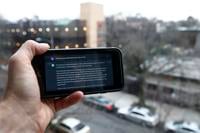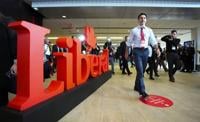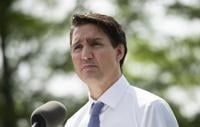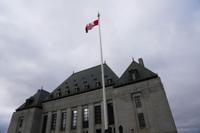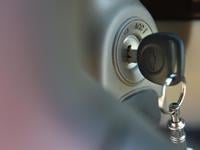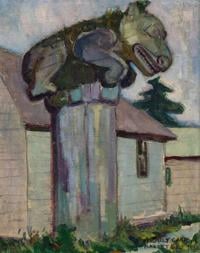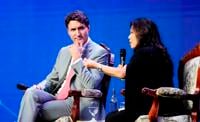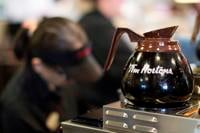of robocalls impersonating U.S. President Joe Biden telling people not to vote in the presidential primary in New Hampshire have raised alarm over politically related fakes in the lead-up to this year's U.S. presidential election. However, not all recent fakes have to do with the current U.S. administration, as was the case with a photo shared online that appears to show former U.S. president George W. Bush sitting with the mastermind of the Sept. 11, 2001, terrorist attacks, Osama bin Laden. The photo is a digitally altered fake. The real photo is posted on the U.S. Department of Defense website and shows former deputy secretary of defense Paul Wolfowitz instead of bin Laden.
"Look Closely. Who do you see?" asks one , formerly known as Twitter, that has been viewed more than 1.2 million times. The grainy photo appears to show former U.S. president Bush sitting with several advisers and former al-Qaida leader Osama bin Laden.
The photo was posted again on X by a popular account, which wrote, "The CIA says this picture is fake." That post was viewed more than 1.3 million times before it was deleted on Jan. 23.
Rating: False
According to U.S. Department of Defense, the was taken as then-secretary of defense Donald Rumsfeld introduced his staff members to Bush at a Pentagon meeting on Sept. 12, 2001, the day after the terrorist attacks that brought down the World Trade Center towers.
The photo is credited to Greg Mathieson, for MAI Photo News Agency, in its , which also provides a higher-quality version.
Included in the photo are Wolfowitz, former secretary of the army Thomas White, former secretary of the air force James Roche, then-chairman of the joint chiefs of staff Gen. Henry H. Shelton, then-secretary of the Navy Gordon England, then-White House chief of staff Andrew Card and former national security adviser Condoleeza Rice.
Along with removing Wolfowitz and replacing him with bin Laden, the altered photo is cropped and has been made to appear significantly older and more faded than the original.
Spotting manipulated media
Even as people online began identifying the photo as a fake, not everyone was convinced. One user shared a screenshot of the photo submitted to a website that detects the use of artificial intelligence, with the result coming back as "highly likely to be human generated."
"Looks real to me," , in a reply that has been viewed more than 27,000 times.
That user is relying on websites or software programs that have emerged over the past several years, promising to detect the use of artificial intelligence in media.
Philippe Pasquier, director of Simon Fraser University's Metacreation Lab for Creative AI and a professor in generative AI, says an "arms race" of sorts has been created between the artificial intelligence used to create deepfakes, media that has been manipulated with the help of AI to create a false narrative, and the systems built to detect them.
"In fact, the way we train … those generators is by training a generator on one side, and a detector on the other side. And those networks compete and sort of play a game with each other," he said.
"And so by definition, the next generation of algorithm is going to be trained to defeat whatever detection algorithm we have now."
He called detecting fakes and deepfakes "an open problem," adding that currently "the truth is, we don't know how to do it with any sort of reliable accuracy."
He says the fake image of Bush and bin Laden appears to have been made using a common graphics editing program such as Photoshop, rather than artificial intelligence.
"It's an image, plus a collage of another one, plus a little blur, plus a filter, to make it look like an old picture. So it's all probably human-made in Photoshop," he said.
"So technically, when the AI detector tells us that it's human-made, it's right. But it's a human-made fake."
Research into people's ability to spot fake images or deepfake videos is limited.
A report in 2021 found that people cannot reliably detect deepfake video and often overestimate their ability to know when they are being tricked. The authors also reported participants had a bias toward guessing videos they watched were authentic.
, looking specifically at static images, had slightly more optimistic findings. It found that people got better at guessing which images were manipulated the more they were exposed to them, plateauing at an accuracy rate of about .
Politically themed fakes
Hany Farid, a professor at the University of California-Berkeley specializing in digital forensics, says he expects to see more politically themed fakes pop up as his country nears an election later this year.
"We've been seeing lots of deepfakes of (Gov. Ron) DeSantis and of (Donald) Trump and Biden on an almost daily basis. This is coming," he said, adding that the problem affects elections held worldwide.
He says there's currently a "perfect storm" created by the ability for the average person to create manipulated media with very little effort, the ability to publish those lies online easily through social media, and algorithms on social media designed to amplify the message.
"We have an electorate that is highly partisan and hateful and distrustful. And so they amplify and absorb," he said.
"So it's the whole life cycle: create, distribute, amplify, create, distribute, amplify, and I think that you have to break that cycle in a number of different places."
Farid says social media sites need to get better at content moderation, particularly around political content during elections. At the same time, courts should hold tech companies responsible.
He adds it's important to remember that not all attempts to deceive people will come as a result of high-tech systems like artificial intelligence.
"We shouldn't, in our excitement to talk about generative AI and deepfakes, forget about (how) you can still Photoshop people into photos. It's not that hard."
Sources
Claim can be found on X, formerly Twitter, () and in a deleted post archived
()
()
()
()
()
()
()
()
()
About ��ɫtv Press fact checks
You can find out more about ��ɫtvhere and about ��ɫtv Press Fact Checks here. To reach our fact-checking team with any tips, corrections or comments, please email us at cpfactcheck@thecanadianpress.com.




